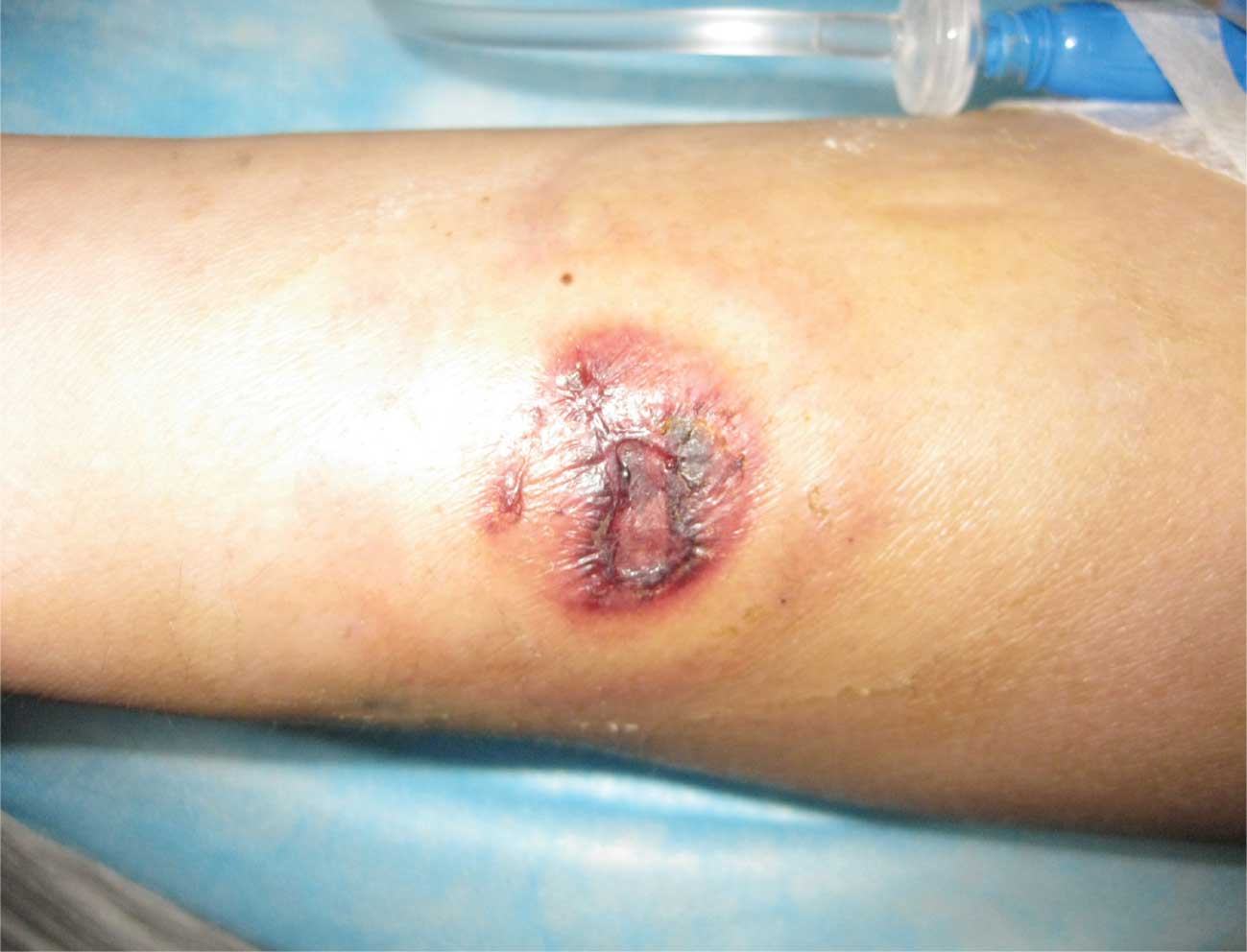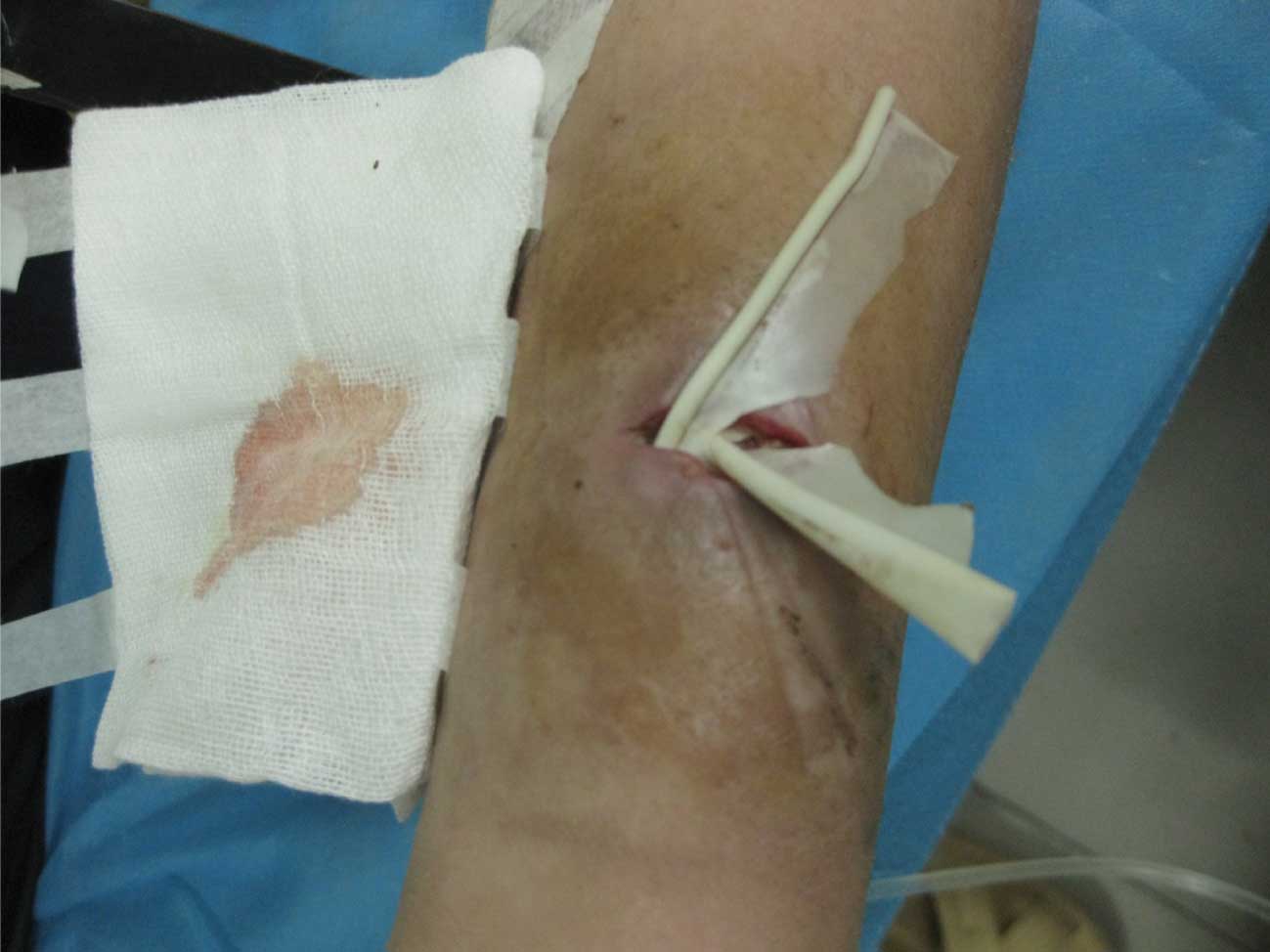Introduction
As society develops, the population is faced with
increasing social pressures and family conflicts. Suicide rates are
also increasing, particularly among young people, and ingestion of
agrochemicals is one of the most common methods used in China
(1). In developing countries,
household insecticides are easily obtained, contributing to the
occurrence of suicide. Household insecticides are classified as
chlorinated hydrocarbons, acetylcholinesterase inhibitors and
botanical agents. Acetylcholinesterase inhibitors include
carbamates and organophosphates (OPs) (2). Organophosphorus
cholinesterase-inhibiting insecticides are divided into two groups,
highly toxic and moderately toxic. Phoxim falls into the latter
group. The use of the parenteral route to self-administer this
poison is extremely rare (3,4).
Fratello et al(3) presented
a case of acute OP ester poisoning via a parenteral route. Güven
et al(4) reported the first
case of OP intoxication by intravenous (i.v.) injection. However,
to the best of our knowledge, the present study is the first
reported case of suicidal poisoning by intramuscular injection of
OP in China. The study was approved by the Ethics Committee of Qilu
Hospital of Shandong University. (Jinan, China). Written informed
consent was obtained from the patient.
Case report
A 33-year-old married male was admitted to The
Department of Poisoning & Occupational Disease, Qilu Hospital
of Shandong University, Shandong, China, following attempted
suicide by injection of phoxim (~10 ml) into the distal region of
the left arm. Upon interview, the patient confirmed that the
suicide attempt had occurred 9 days prior to admission. The patient
was discovered 3 h after the incident and a ventouse was used at
the injection site. No systemic signs of intoxication were observed
at the time. However, the patient later developed diarrhea and
vomiting, and was admitted to the local hospital for emergency
treatment. The patient was immediately diagnosed with
organophosphorus insecticide poisoning, and i.v. atropine and
pralidoxime therapy was administered (specific quantities unknown).
The patient was referred to the Department of Poisoning and
Occupational Disease for further treatment nine days later.
The patient had previously experienced a
craniocerebral trauma. On physical examination, the patient was
conscious, with a blood pressure of 120/75 mmHg, a pulse of 85
beats/min, pupils of equal roundness and size (left, 2 mm; right, 2
mm) and a positive light reflex in both eyes. The patient exhibited
spontaneous respiration and his respiratory sounds were exaggerated
at a rate of 25 breaths/min. Neurological and abdominal
examinations were normal. The distal region of the left arm was
swollen and exhibited an erythematous reaction. The diameter of the
pale-cicatrix was ~2 cm (Fig. 1).
Serum cholinesterase levels were 200 IU/l (normal reference,
5,900–12,220 IU/l). An i.v. infusion of crystalloid solution was
administered. Atropine therapy (i.v.; 2 mg twice a day followed by
2 mg every 4 h) was continued for 2 days and an intramuscular
injection of pralidoxime chloride (0.5 g) was administered once
daily. Atropine therapy was continued for 15 days. This therapeutic
regimen was continued for 15 days; however, the doses were changed
during this time. It was difficult to titrate the atropine dose as
the patient had received i.v. atropine and pralidoxime chloride
therapy prior to admission. Furthermore, the dose of atropine was
changed a number of times according to serum cholinesterase
levels.
For two days following admission, serum
cholinesterase levels were 200 IU/l. On day 4, serum cholinesterase
levels were 341 IU/l. Laboratory tests revealed a white blood cell
(WBC) count of 14.38×109/l and lactate dehydrogenase
(LDH) and LDH1 isoenzyme levels were slightly increased. Cranial
computed tomography (CT) revealed a crevice in the frontal bone of
the patient, likely caused by the previous craniocerebral trauma,
and no abnormalities were observed in the brain parenchyma. A chest
CT scan revealed left lower pulmonary fibrotic foci and an abdomen
CT scan was normal. On day 5, serum cholinesterase levels were 324
IU/l and the symptoms were not improved. On day 7, the patient
deteriorated, becoming drowsy and developing weakness. Laboratory
findings were as follows: cholinesterase (CHE), 334 IU/l; K, 3.34
mmol/l; LDH, 236 U/l; WBC, 18.12×109/l; and platelets
(PLT), 311×109/l. On day 9, serum cholinesterase levels
were 433 IU/l. Following day 12, the patient appeared to improve,
exhibiting alleviated symptoms, including reduced pain and
drowsiness, and an increased serum cholinesterase level of 1240
IU/l. On day 14, the patient accidentally scratched the cicatrix on
the upper left limb. This led to bursting of the skin, pouring
bloody liquid, which had a heavy OP insecticide odor. Immediate
surgical debridement, incision and drainage were carried out. The
necrotic tissue at the injection site was excised and the dressing
was changed regularly (Fig. 2). On
day 15 after admission, serum cholinesterase levels were elevated
to 1,877 IU/l, although this remained below the normal range.
Routine blood, kidney and liver function examinations revealed
normal values. Atropine and pralidoxime chloride were discontinued.
By day 21, serum cholinesterase levels had increased from 1,877 to
3,823 IU/l and symptoms had resolved completely. The patient was
discharged from the hospital.
Discussion
Phoxim is an OP compound. OP insecticides strongly
inhibit cholinesterase and pseudocholinesterase activities
(5). Phoxim is also known as
Volaton or Baytion (phenylglyoxylonitrile oxime O,O-diethyl
phosphorothioate) and is a highly effective OP pesticide with a low
toxicity. It is used as an insecticide and acaricide, mainly to
treat grains, including rice, sorghum, wheat, corn and beans, prior
to storage or before sowing to prevent attack by worms. OP
poisoning occurs mainly via the gastrointestinal and respiratory
tracts and the skin. Exposure to the chemical via other routes
causes varying symptoms. The type and severity of symptoms depend
on the amount of OP involved and the nature of the exposure. The
initial treatment of poisoning focuses on ensuring adequate
oxygenation, followed by the administration of atropine to
antagonize the muscarinic and central nervous system effects of the
OP (6). Pralidoxime is usually
used in the case of respiratory depression, muscle fasciculations
or muscular weakness to antagonize the toxicity of OPs on nicotinic
synapses (7). The dose of atropine
and pralidoxime should be controlled flexibly. In the present case,
signs or symptoms of systemic toxicity resulting from the
intramuscular injection of OP did not manifest immediately. This
may have been due to the amount of OP injected and the low level of
OP transition to the circulatory system (8). Fasciotomy and surgical debridement
were not performed until the patient accidentally scratched the
cicatrix. This case differs from previous studies (8–10),
as the cicatrix was old and scabbed upon referral, thus it was not
considered to be significant. Measurements of plasma cholinesterase
and erythrocyte cholinesterase activities are the most useful
methods for confirming OP exposure. Prior to the fasciotomy and
surgical debridement, serum cholinesterase levels fluctuated
between 200 and 433 IU/l; however, these were rapidly elevated
following surgery. Therefore, we suggest that immediate application
of fasciotomy and surgical debridement should be established to
prevent later complications, including ischemic contracture or limb
amputations, which have been shown to occur in a previous study
(11). In the present case, a
prolonged course of treatment was required since fasciotomy and
surgical debridement were not performed immediately. Therefore,
immediate fasciotomy and surgical debridement are indicated to be
necessary. Furthermore, surgical debridement may also aid in the
clearance of toxic substances and contribute to the prevention of
possible systemic toxicity.
References
|
1
|
Zhang X, Li HS, Zhu QH, et al: Trends in
suicide by poisoning in China 2000–2006: age, gender, method, and
geography. Biomed Environ Sci. 21:253–256. 2008.
|
|
2
|
Buchman MT: Upper extremity injection of
household insecticide: a report of five cases. J Hand Surg Am.
25:764–767. 2000. View Article : Google Scholar : PubMed/NCBI
|
|
3
|
Fratello U, D’Auria C, De Vita A, Fasano
C, Marra F, et al: Unusual case of acute organophosphate ester
poisoning by parenteral way. Minerva Anestesiol. 40:331–336.
1974.(In Italian).
|
|
4
|
Güven M, Unlühizarci K, Göktaş Z and
Kurtoğlu S: Intravenous organophosphate injection: an unusual way
of intoxication. Hum Exp Toxicol. 16:279–280. 1997.PubMed/NCBI
|
|
5
|
Worek F, Koller M, Thiermann H and Szinicz
L: Diagnostic aspects of organophosphate poisoning. Toxicology.
214:182–189. 2005. View Article : Google Scholar : PubMed/NCBI
|
|
6
|
Paudyal BP: Organophosphorus poisoning.
JNMA J Nepal Med Assoc. 47:251–258. 2008.PubMed/NCBI
|
|
7
|
Jokanović M: Structure-activity
relationship and efficacy of pyridinium oximes in the treatment of
poisoning with organophosphorus compounds: a review of recent data.
Curr Top Med Chem. 12:1775–1789. 2012.PubMed/NCBI
|
|
8
|
Güloglu C, Aldemir M, Orak M and Kara IH:
Dichlorvos poisoning after intramuscular injection. Am J Emerg Med.
22:328–330. 2004.PubMed/NCBI
|
|
9
|
Yucel I, Demiraran Y and Alper M: Suicide
attempt with injection of insecticide in both wrists. Orthopedics.
31:1742008. View Article : Google Scholar : PubMed/NCBI
|
|
10
|
Bala I, Pratap M, Nakra D and Ramprabhu T:
Prolonged cholinergic crisis and compartment syndrome following
subcutaneous injection of an organophosphate compound for suicide
attempt. J Forensic Leg Med. 15:256–258. 2008. View Article : Google Scholar : PubMed/NCBI
|
|
11
|
Aydin A, Aköz F and Erer M: Subcutaneous
injection of insecticide for attempted suicide: a report of two
cases. Acta Orthop Traumatol Turc. 38:295–297. 2004.(In
Turkish).
|
















